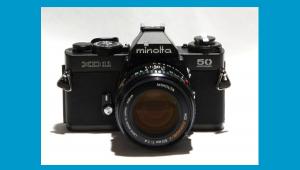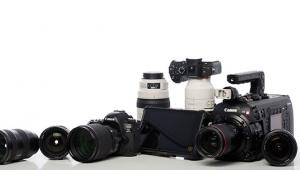Olympus E-P1

Olympus has a long history of miniaturizing camera technology. The first-generation Olympus PEN appeared in 1959 and led the way to high-quality images in a small package, matching SLR cameras’ performance of the era.Today, Olympus utilized its miniaturizing and engineering expertise to create a slimmer body, removing the optical viewfinder and mirror box found inside a traditional DSLR, to create a small but high-quality interchangeable lens camera. By reducing its lens mount diameter, Olympus also enabled the production of smaller and lighter lenses to match the E-P1’s body size.
The camera’s retro-style metal body design is available in either silver or white with accompanying new small and lightweight Olympus M. ZUIKO Micro Four Thirds lenses: 14-42mm f3.5-5.6 (28-84mm equivalent) and 17mm f2.8 (34mm equivalent).
The E-P1 offers In-body Image Stabilization, fast Imager Autofocus, the proven Olympus Dust Reduction System and the new TruePic V Image Processor. As the first Micro Four Thirds camera from Olympus, the E-P1 provides the same image quality as current Four Thirds format E-System cameras because it has the same image sensor size as the E-30 and E-620 DSLR models, but in a much smaller body. This high-performance 12.3-megapixel Live MOS image sensor is said to deliver excellent dynamic range, accurate color fidelity, and a state-of-the-art amplifier circuit to reduce noise and capture fine image details in both highlight and shadow areas.
With the new Live Control function, icons appear on the LCD, making it easy to compose, edit and shoot pictures or videos without stopping to access various menus. The E-P1’s fast Imager Autofocus in Live View also enables you to compose, focus and capture the shot quickly and easily without ever taking your eyes off the large LCD.
The LCD displays 230,000 pixels in vivid color and includes HyperCrystal technology, which offers many times the contrast of conventional LCD monitors for easier viewing in both preview and playback. It also provides a wide viewing angle of 176 degrees, which ensures that images can be composed from even the most obscure angles.
Olympus pioneered easy-to-use Art Filters for still images captured inside its E-System DSLRs, and now those same In-Camera Creative Features are built into the E-P1 with a fresh twist – they can also be applied to High Definition video recordings to take your videos to a new level of creative expression and put you in the director’s chair.
Your movies and YouTube videos will have the incredible clarity of HD whether Art Filters are applied or not. Just imagine how dramatic and unique your videos will appear with any one of the six in-camera Art Filters applied as effects: Pop Art, Soft Focus, Pale & Light Color, Light Tone, Grainy Film or Pin Hole. Whether you’re a videographer, documentarian or established director – or just want to shoot like one – Art Filters set your images and videos apart from the pack. Since they’re built into the camera, you can achieve dramatic results on the go without needing a computer or editing software.
Because the E-P1 is an interchangable lens system camera you have more creative options in composition for video capture, to add to your visual palette. You can attach any one of the new super-compact Micro Four Thirds lenses or, because the camera can accept many of the other Four Thirds Format lenses with an available MMF-1 Four Thirds System Lens Adapter, you can add anything from an extreme wide-angle fisheye lens to a super telephoto lens for a wide range of expressive options. All the while you will have more DSLR-like control over depth of field, focus, white balance and ISO.
When viewing the LCD in Live View, Art Filter effects and settings like white balance and exposure are viewable right on the LCD, and their impact is seen instantly on the display.
With the E-P1’s Multiple Exposure function available for still image capture you are free to tell a visual story your way, whether in a portrait, a landscape or a combination of both. The image capture options allow you to shoot one shot, then another and combine them in real time, or capture both shots separately and combine them in the camera later.
The E-P1 provides four aspect ratios that serve as masks to frame your image to the desired proportions, including: the standard 4:3 aspect ratio that is perfectly suited to an 8 x 10-inch enlargement; the 16:9 aspect ratio that will display your images beautifully on a widescreen television; and other popular aspect ratios such as 3:2 and 6:6. The Multi-Aspect Shooting further expresses your creative vision when combined with Art Filters and multiple exposures.
Like the innovative Olympus LS-10 portable audio recording device that puts the power of a recording studio in your pocket, the E-P1 features uncompressed 16 bit/44.1kHz Linear PCM recording capability to capture the rich sound quality of your scene. It has the versatility to record and play back in the WAV format and can record with its built-in stereo microphone.
The E-P1 is equipped with 19 automatic scene modes for effortless picture taking. Standard scene modes like Night-Scene, Portrait and Landscape are easy-to-use solutions for everyday shooting. Capturing beautiful portraits is easy with the new ePortrait Mode. It enables you to smooth your subject’s face – all in the camera and before capture. Additionally, edits can be made post-capture using the ePortrait Fix mode.
Shooting scenes with both highlights and shadows can often be dicey because of the extreme contrast between dark and bright areas. The E-P1 addresses this challenge with Shadow Adjustment Technology that adjusts for extreme light variations and maintains visible detail in both the shadow and highlight areas of the scene. Now users can see and preview the gradation on the Live View LCD and capture images showing the shadow detail they saw. This feature is also accessible in the Edit menu after the shot has been taken.
The E-P1’s Face Detection reduces the chance of blurred subjects in images by recognizing up to eight people’s faces and the background, tracking the faces within the image area, even if people are moving, and automatically focusing and optimizing exposure for sharp, brilliant portrait pictures (ideal for large family or party group photos).
The New Super Control Panel with Live Control technology, along with the camera’s intuitive button layout, enables you to see both the image and the controls on the 3-inch HyperCrystal LCD, making the camera simple to use. The E-P1 records to SDHC media cards to accommodate large files including videos with In-Camera Creative Features and uncompressed audio.
In addition to the new Micro Four Thirds lenses, Olympus also offers an optional Clip-on Optical Viewfinder for use with the Micro Four Thirds 17mm f2.8 (34mm equivalent) lens. The MMF-1 Four Thirds System Lens Adapter enables all Olympus ZUIKO Digital lenses as well as Four Thirds System lenses from Sigma, Panasonic and Leica lenses to attach to the E-P1. If you have Olympus OM lenses and want to attach them to the E-P1, that is possible with the MF-2 OM Lens Adapter. Additionally, an optional FL-14 flash unit, suitably small for the camera, adds more lighting versatility to your shots.
Availability
The Olympus E-P1 will be available in July 2009.
U.S. Pricing / Product Configurations
E-P1 Body Estimated Street Price: $749.99
E-P1 Body with ED 14-42mm f3.5/5.6 Zuiko Digital Zoom Lens Estimated Street Price: $799.99
E-P1 Body with ED 17mm f2.8 with optical viewfinder Estimated Street Price: $899.99
- Log in or register to post comments

















































